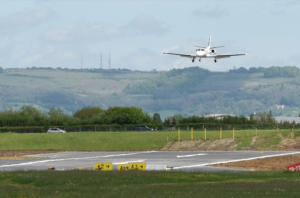The Queen’s Cup, usually stored at the Royal Air Force Museum, is the oldest and most prestigious sporting trophy in the UK, dating back to 1719. In 2010 it was entrusted to the Royal Aero Club by its patron, Her Majesty Queen Elizabeth II, who originally received the trophy as a wedding gift in 1947.
The trophy is made of Irish sliver and has the Royal Arms on one side and the inscription “The Queen’s Air Race Challenge Cup” on the other.
Since 2010, the Queen’s Cup has been the prize up for grabs for numerous air race challenges brought forward by Royal Aero Club member associations, including the British Aerobatic Association, British Model Flying Association, Helicopter Club of Great Britain, and British Skydiving.
For 2023, the Royal Aero Club has selected the British Balloon and Airship Club (BBAC) to host a Queen’s Cup event.
The BBAC is a volunteer-based organisation which exists to promote the safety, enjoyment and advancement of lighter-than-air flight in all its forms – hot-air ballooning, gas ballooning and airships.
For the first time in 10 years, the Queen’s Cup will be contested by a hot air balloon race setting off from Gloucestershire Airport in October 2023. The event has already attracted entries from some of the most adventurous and characterful pilots and crew in the country.
Gloucestershire Airport is one of the UK’s busiest general aviation airports, handling around 80,000 aircraft movements per annum. As well as being the chosen launch site for the event, it will also act as a base from which the competition will be directed.
Competition balloonists and their crews will launch from Gloucestershire Airport’s recently refurbished main runway on a Saturday morning this autumn at dawn and head off wherever the winds will steer them. The winner will be the crew that touches down furthest away, in a straight line, from the airport on the Sunday evening.
The balloon race won’t just test pilots’ skill, but also team tactics.
Competitors will receive the specific competition rules at the launch briefing shortly before the competition begins. Once briefed, pilots and their crews will need to quickly consider and calculate a number of things – meteorological data for the whole of the UK, the likely tactics of other teams, when to land, where to relocate to launch again, and when to refuel.
In the 2013 event, the last time the Queen’s Cup was contested by a hot air balloon race, winner Richard Parry flew to the south coast before repositioning to use winds to fly to Norfolk, eventually landing near the coast to take the prize.
Chair of The Queen’s Cup for the British Balloon and Airship Club, Stephanie Hemmings, said: “We are grateful to be warmly hosted by Gloucestershire Airport. The location, facilities and accessibility should all add up to a great start for our competitors’ adventures in 2023.
“Social media and technology have developed a lot in the last 10 years since the BBAC last hosted the Queen’s Cup, so we’re very excited as to how it will make the event more accessible to everyone. We have a great range of balloonists entering the event, so it will be very interesting to see how each adopt different tactics.”
Gloucestershire Airport’s Managing Director, Karen Taylor, commented: “It’s a great honour to have been chosen to host the 2023 Queen’s Cup hot air balloon race. Everyone at the airport is thrilled to be a part of what is an historic and prestigious event. We’re currently working closely with the event organisers to confirm all necessary details and plan how we’ll deliver the event. We’re very much looking forward to playing host and getting the competition underway. We’ll share more detail as soon as we have it. Watch this space.”




